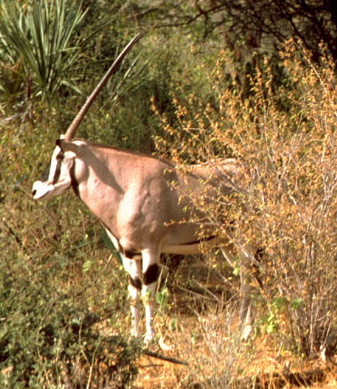East African Oryx (Oryx beisa) - Wiki East African Oryx
From Wikipedia, the free encyclopedia
[Photo] East African Oryx (Oryx beisa) by http://en.wikipedia.org/wiki/User:Jimfbleak License: public domain
The East African Oryx (Oryx beisa, also known as the Beisa Oryx) occurs in two subspecies, Beisa Oryx Oryx beisa beisa found in steppe and semi-desert throughout the Horn of Africa and north of the Tana River, and Fringe-eared Oryx Oryx beisa callotis south of the Tana River in Kenya and parts of Tanzania. Some taxonomists consider it a subspecies of the Gemsbok (Oryx gazella), but they are genetically distinct (2n=56 for Beisa and 2n=58 for Gemsbok).
East African Oryx stand just over a metre at the shoulder and weigh around 175 kilograms. They have a grey coat with a white underside, separated from the grey by a stripe of black, there are also black stripes where the head attaches to the neck, along the nose and from the eye to the mouth and on the forehead. There is a small chestnut coloured mane. The ringed horns are thin and straight. They are found on both sexes and typically reach a metre or more.
East African Oryx live in semi-desert and steppes where they eat grass, leaves, fruit and buds. East African Oryx are able to store water by raising their body temperature (so as to avoid perspiration). They gather in herds of five to forty animals often with females moving at the front and large male guarding from the rear. Some older males are solitary. Radio tracking studies show that solitary males are often accompanied for brief periods by breeding condition females, so it is probable they are exectuting a strategy to maximise their chances of reproduction.
http://en.wikipedia.org/wiki/East_African_Oryx
| The text in this page is based on the copyrighted Wikipedia article shown in above URL. It is used under the GNU Free Documentation License. You may redistribute it, verbatim or modified, providing that you comply with the terms of the GFDL. |
